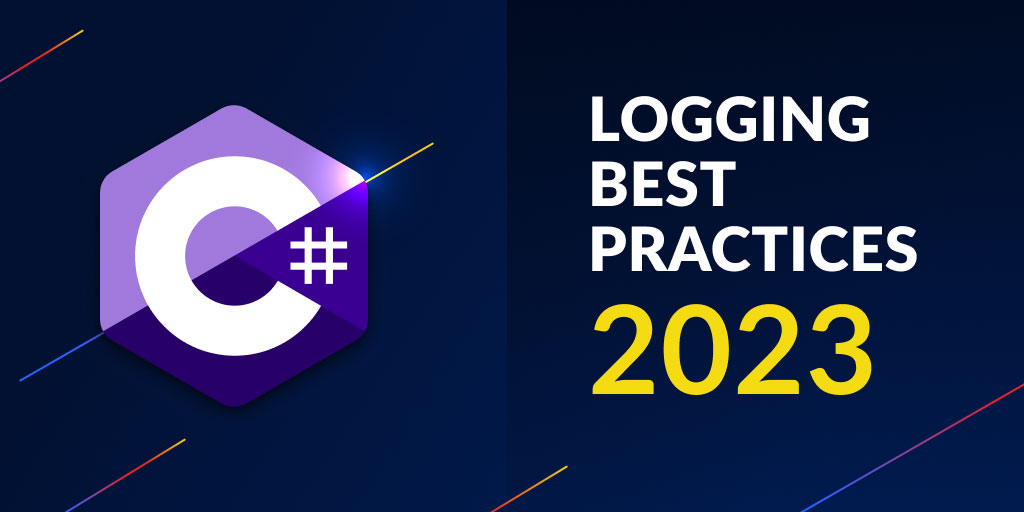Alerting has landed: Never miss another mission-critical issue again
Posted Oct 26, 2021 | 9 min. (1733 words)Time is of the essence when identifying and resolving issues in your software. The longer it takes for a fix to be deployed, the greater the consequences for your customers. Visibility and speed are core to what makes Raygun powerful and is why today we’re excited to continue this journey with our latest feature – Alerting.
Alerting is available for both Crash Reporting and Real User Monitoring, meaning you can quickly be made aware of the errors, crashes, and front-end performance issues that matter most to your business. Get complete control over what triggers an alert and assign users to ensure that the relevant developers are working on a fix, ensuring minimal disruption to your end-users.
Take action quickly against issues in your software
Every piece of software will encounter issues at some point and even the most reliable developers push bugs into production. What separates great developers is not their ability to stop bugs from occurring in the first place, but instead their ability to quickly identify and resolve issues once they arise.
Speed is the key factor. The sooner that you are made aware of an issue, the faster a fix can be deployed. Having a seamless issue resolution workflow that minimizes the time issues are in the hands of your users is essential for consistently delivering quality digital experiences. Any lag in this workflow increases friction and pain for your users, which has a direct impact on business outcomes.
With Alerting, you will be made aware of an issue the second it occurs, giving you peace of mind that if something goes wrong you’ll know about it, and that the right people are working on a resolution.
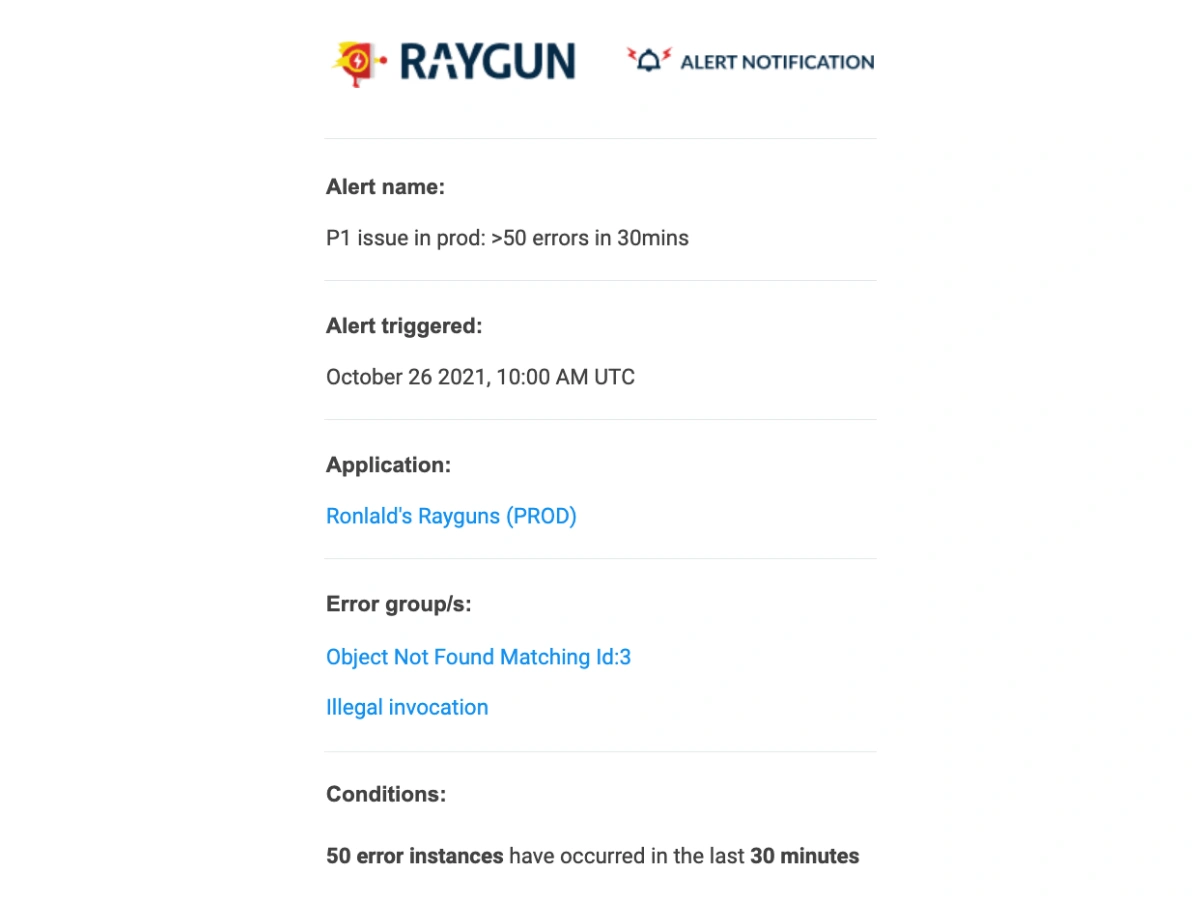
Customize alerts for complete control
Set thresholds for your alert based on an increase in error count, a spike in load time, or a new error occurrence, with custom filters that give you even greater control. Once an alert goes off, the relevant stakeholders will promptly receive an email about the issue. Alerts link directly to the issue in Raygun, with actionable diagnostics that take you to the root cause, empowering you to deploy a fix faster.
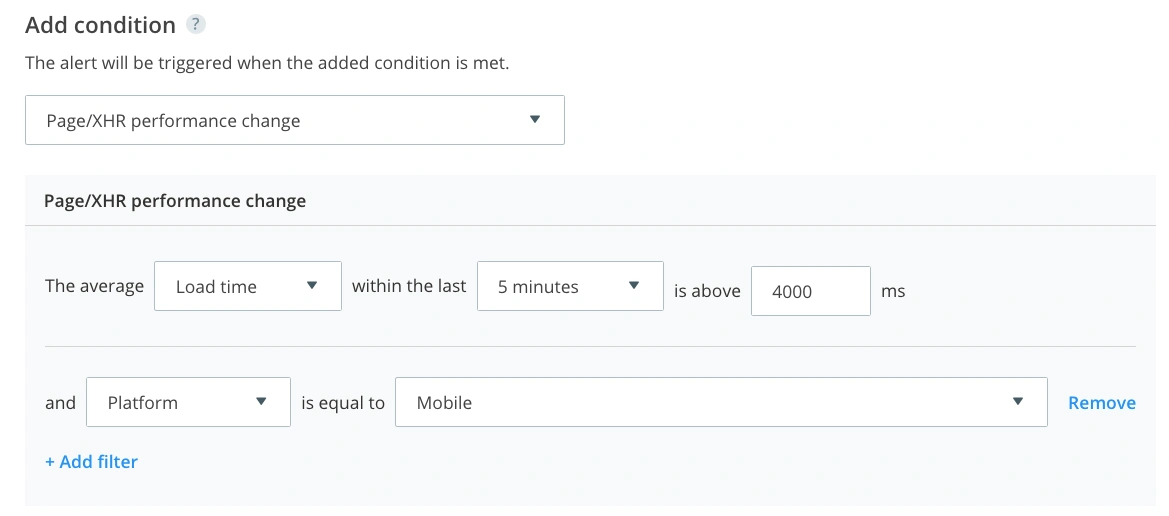
If you’re wanting to monitor a recent launch, you can do so by filtering your alert by ‘Version number’. This will ensure you have total visibility into any issues that may have been introduced, giving your team the confidence needed to ship better quality software, faster.
Reducing noise is one of the most effective ways to streamline your workflow. Time wasted digging through countless notifications is better spent actively working on and resolving the issues themselves – or better yet, building new features. For even greater control, you can choose to opt in to only receive emails about specific alerts.
Alerting is plan-based, meaning you can create a single alert for a specific scenario (such as a checkout error or performance spike) and add the users who you want to be notified once the issue arises. This ensures a consistent setup across your entire team, giving visibility to everyone that needs it. If you have the right permissions, you’ll be able to manage other team members’ notifications, including adding and editing group settings.
Create your first alert in three easy steps
Follow this simple three-step process to create your first alert. Use this as a guideline only, and feel free to adapt it to meet your specific needs.
Step 1: Name alert and select application:
Writing an effective alert name: Be concise but descriptive when writing an alert name. Your alert name will be pulled into your email subject line, so try to convey as much information in as few words as possible. Standardizing an alert name format with your team is an effective way to ensure your alerts are all consistent and organized.
Some useful pieces of information to include in your alert name are:
- Alert priority: Is this a mission-critical alert or just nice-to-know?
- Application: Which application triggered the alert?
- Environment: Did the alert occur in production, beta, etc?
- Trigger criteria: What conditions caused the alert to be triggered?
You will need to remain within the 60 character limit, so only include information that is important and relevant. Avoid using long sentences, so instead of having the alert name such as “High priority: There was an issue in the Raygun Application in Production triggered by 50 errors in 30 minutes”, try something like “P1 issue in Raygun app Prod: >50 errors in 30m”.
Select application: If you’re planning on having the same trigger criteria for multiple applications, you have the option of bundling them together. This will ensure that you have a consistent setup, with a standardized approach to alert criteria and filters. You may want to bundle based on environment, priority, programming language, etc, but ultimately you can bundle by any dimension that you think will be useful.
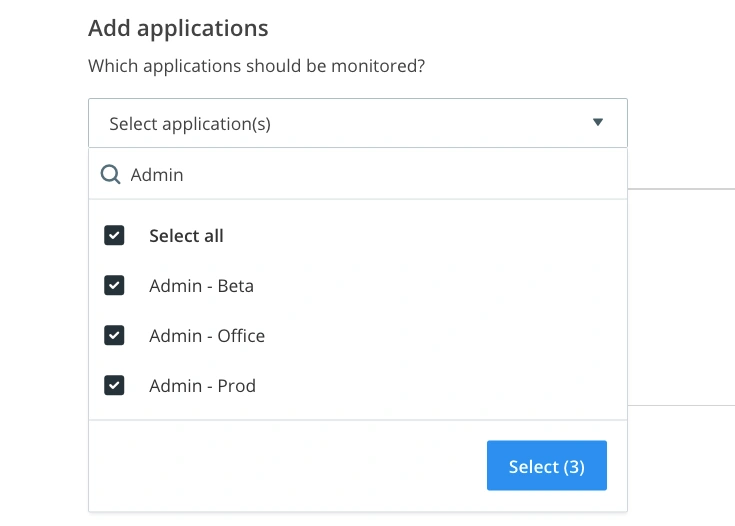
Bundling alerts together will also keep your alert list concise and orderly, making it easy to navigate for your wider team. Naming your applications based on what you want to filter by is a great way to bundle easily (e.g. including ‘PROD’ in all production application names). However, if you have a particularly crucial alert that is specific to one application, don’t feel as though you need to bundle it for the sake of bundling it. Keeping it separate is a good way to emphasize its importance.
Step 2: Add conditions and filters:
Conditions: Now, you’ll be able to decide what triggers your alert. Here, you’ll be able to select one of the following conditions to be the catalyst for your alert:
- New error group occurs: Receive notifications whenever a new type of error group occurs on your selected applications. You can choose to set a threshold for a number of new error groups within a specific interval to be hit before the alert is triggered. This can be useful to see if recent updates have introduced new errors.
- Error group reoccurs: Get notified when an instance of an existing error group occurs again. You can choose to set a threshold for a number of error groups in a selected interval before the alert is triggered. Setting this condition alerts you when a fix has not addressed all known errors.
- Error group occurs: If you want to monitor specific types of error groups, choosing this condition allows you to get notified when a threshold of instances has been hit in a specified interval.
- Error instance occurs: In order to be notified whenever one or more instances of an error occur within an interval, choose to set up this condition together with filters for specific attributes of the errors or source.
- Page/XHR performance changes: Monitor your RUM enabled applications for changes in page load time, FCP, and Core Web Vitals by setting a threshold timing or score that will trigger a notification when it hits at least once in your specified interval. Note that the threshold refers to averages across all page loads / XHR calls during the interval. You can narrow down the type of traffic to monitor by applying the according filters.
The first four conditions give you control over Crash Reporting alerts, while “Page/XHR performance changes” relates to Real User Monitoring.
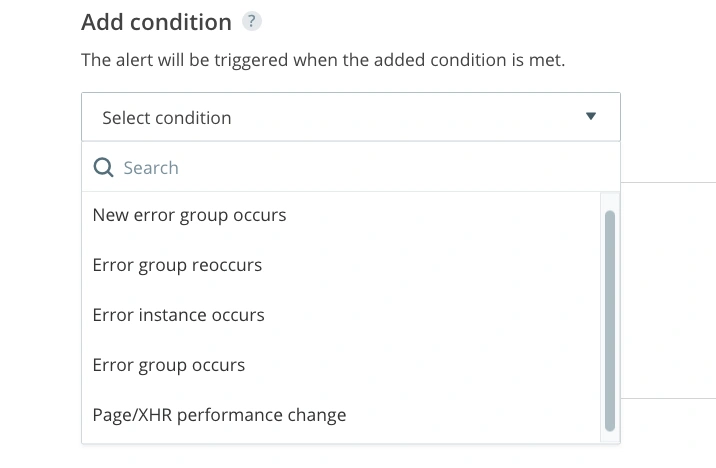
Thresholds: For Crash Reporting alerts, you set triggers based on the number of occurrences within a specific timeframe. Make sure that you select a number of occurrences that is greater than what you already have, to ensure you’re identifying a spike outside of normal behavior.
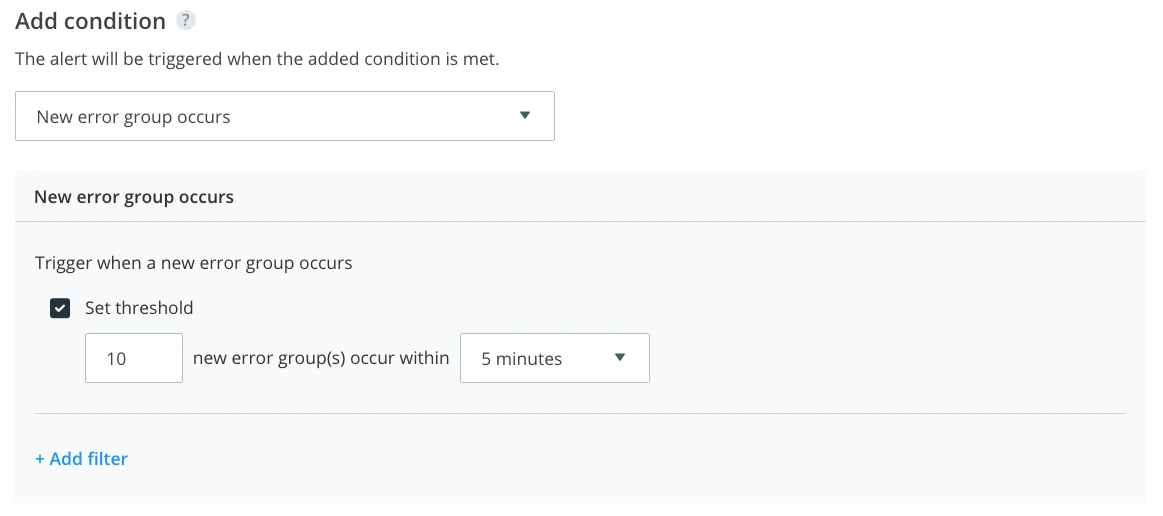
For RUM you can set triggers based on a performance metric, such as load time, FCP, LCP, FID, or CLS exceeding a certain limit within a timeframe.
Filters: For all Crash Reporting conditions, you’ll be able to add additional filters, such as Error Message, Tag, and Version. When looking at changes in page/XHR performance timings, you’ll be able to filter by Country, Platform, Tag, Version, and URi.
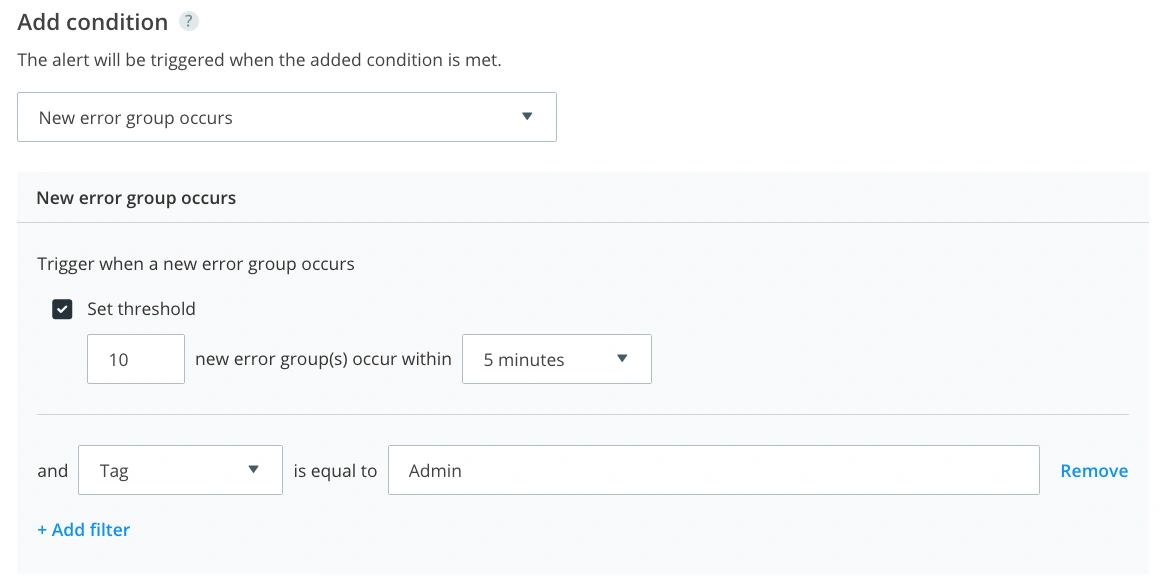
Step 3: Assign team members
Finally, you’ll be able to assign individual users to your alert. Look to include: relevant developers, your on-call team, and subject experts, as well as any other stakeholders who need visibility into emerging issues in your application.
For a consistent setup across your whole team, we recommend that you add multiple users to the same alert instead of having multiple users create an alert of the same type. This ensures that your team is all on the same page about the criteria of the alert, and avoids confusion down the road.
The permission settings associated with your Raygun account will dictate what access each user has to your alerts. Not every user type has the ability to edit or delete an alert, so ensure that you’re happy with the permission structure located in your account settings.
Sync email alerts with Slack
By integrating your email provider with Slack, you can forward any alert emails directly to a Slack channel of your choice. Simply follow the integration documentation to get started. All alerts forwarded to Slack will include the same functionality as the email alerts, allowing you click through to the issue in Raygun.
Coming soon: 3rd party integrations with Raygun Alerting
Work is already well underway to integrate other third-party tools with Raygun Alerting. These include tools you already know and love, such as Slack, Microsoft Teams, Azure DevOps, Atlassian Opsgenie, PagerDuty and many more, so you can send alerts wherever you need them the most.
If you’d like to be an Alerting integration beta tester for us or would like to be notified of Alerting integrations as they become available, then please fill out this simple survey, and we will be in touch as soon as they are available for user testing.
Get started today
Software moves fast, and even when with a diligent process in place for deploying quality software, issues will inevitably slip through the cracks. That’s why when building software, it’s never been more important to have constant visibility into the health of your application, and Alerting gives you just that.
Take control of your software and have peace of mind that your users are consistently getting the digital experiences they deserve.
If you’re a current Raygun customer, simply log in and go to the Alerting tab in-app. Or if you’re new to Raygun, you can take a free 14-day trial, no credit card required. Pricing is on-demand and starts from as little as $4 per month, so get started today.


